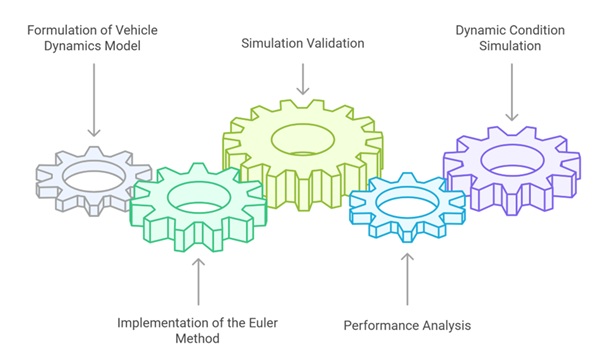Modeling the Movement of Autonomous Vehicles with the Euler Method
DOI:
https://doi.org/10.63876/ijss.v1i3.31Keywords:
autonomous vehicles, motion modeling, Euler method, simulation, MATLABAbstract
The development of autonomous vehicle technology has brought about a revolution in transportation systems, presenting solutions for efficiency, safety, and comfort. One of the main challenges in the development of autonomous vehicles is accurate motion modeling to understand and predict vehicle dynamics in various conditions. This article discusses the application of the Euler Method, a simple but effective numerical method, to model the movement of autonomous vehicles. This method is used to solve differential equations that describe the dynamics of the vehicle, including acceleration, speed, and position based on the input of the control system. Modeling is done through a discrete approach, where changes in variable values are calculated at small time intervals. This study evaluates the performance of the method in various scenarios, such as straight trajectories, sharp turns, and sudden stop situations, which are often encountered by autonomous vehicles in the real world. The simulation was carried out using MATLAB software to visualize the dynamics of movement and analyze the accuracy of the prediction results. The results show that the Euler Method is able to produce fairly accurate modeling on simple scenarios, although there are limitations in dealing with more complex dynamics due to the linear nature of this method. Therefore, further development with more sophisticated numerical methods, such as the Runge-Kutta Method or adaptive algorithms, is needed to improve accuracy on more complex scenarios. This article makes a significant contribution in providing technical and practical references for researchers and developers in optimizing more reliable and efficient autonomous vehicle systems.
Downloads
References
P. D. S. Fink et al., “The Autonomous Vehicle Assistant (AVA): Emerging technology design supporting blind and visually impaired travelers in autonomous transportation,” Int. J. Hum. Comput. Stud., vol. 179, p. 103125, Nov. 2023, doi: https://doi.org/10.1016/j.ijhcs.2023.103125.
W. Zhong, “Application of artificial intelligence digital holography technology based on medical sensors in the development of medical image fusion,” Meas. Sensors, vol. 33, p. 101146, Jun. 2024, doi: https://doi.org/10.1016/j.measen.2024.101146.
S. B. Lawson, M. Ghayoor, X. Fu, A. Tabei, A. Fan, and S. Pasebani, “Thermal profile modeling and microstructural evolution in laser processing of Inconel 625 plates by comparison of analytical and numerical methods,” Manuf. Lett., vol. 41, pp. 730–741, Oct. 2024, doi: https://doi.org/10.1016/j.mfglet.2024.09.091.
Z. Chen, D. Wang, and L. Chen, “Convergence order of one point large deviations rate functions for backward Euler method of stochastic delay differential equations with small noise,” Appl. Numer. Math., vol. 202, pp. 67–88, Aug. 2024, doi: https://doi.org/10.1016/j.apnum.2024.04.013.
S. Sohrabi, D. Lord, B. Dadashova, and F. Mannering, “Assessing the collective safety of automated vehicle groups: A duration modeling approach of accumulated distances between crashes,” Accid. Anal. Prev., vol. 198, p. 107454, Apr. 2024, doi: https://doi.org/10.1016/j.aap.2023.107454.
P. Lavoie, E. Radenac, G. Blanchard, É. Laurendeau, and P. Villedieu, “An improved characteristic based volume penalization method for the Euler equations towards icing applications,” Comput. Fluids, vol. 222, p. 104917, May 2021, doi: https://doi.org/10.1016/j.compfluid.2021.104917.
A. M. Thakkar and V. J. Patel, “Dynamic Simulation of a 12 DoF Biped Robot with Newton-Euler Method using Unit Vector Approach,” Procedia Comput. Sci., vol. 230, pp. 935–945, 2023, doi: https://doi.org/10.1016/j.procs.2023.12.133.
Z. Chen, Y. Zhang, G. Li, and S. Qian, “A well-balanced Runge-Kutta discontinuous Galerkin method for the Euler equations in isothermal hydrostatic state under gravitational field,” Comput. Math. with Appl., vol. 119, pp. 340–350, Aug. 2022, doi: https://doi.org/10.1016/j.camwa.2022.05.025.
N. Paulig and O. Okhrin, “An open-source framework for data-driven trajectory extraction from AIS data—The alpha method,” Ocean Eng., vol. 312, p. 119092, Nov. 2024, doi: https://doi.org/10.1016/j.oceaneng.2024.119092.
H. Moussa, Z. Meira, K. Kadem, and G. Damm, “Modeling and Control of Dynamic Wireless Power Transfer System for Electric Vehicle charger application,” IFAC-PapersOnLine, vol. 56, no. 2, pp. 10045–10050, 2023, doi: https://doi.org/10.1016/j.ifacol.2023.10.872.
Z. Amiri, A. Heidari, N. Jafari, and M. Hosseinzadeh, “Deep study on autonomous learning techniques for complex pattern recognition in interconnected information systems,” Comput. Sci. Rev., vol. 54, p. 100666, Nov. 2024, doi: https://doi.org/10.1016/j.cosrev.2024.100666.
J. Tian et al., “Integrated optimization of charging infrastructure, fleet size and vehicle operation in shared autonomous electric vehicle system considering vehicle-to-grid,” Renew. Energy, vol. 229, p. 120760, Aug. 2024, doi: https://doi.org/10.1016/j.renene.2024.120760.
X. Yang, Z. Yang, and C. Zhang, “Numerical analysis of the Linearly implicit Euler method with truncated Wiener process for the stochastic SIR model,” Math. Comput. Simul., vol. 208, pp. 1–14, Jun. 2023, doi: https://doi.org/10.1016/j.matcom.2023.01.010.
L. Magnolfi and C. Sullivan, “A comparison of testing and estimation of firm conduct,” Econ. Lett., vol. 212, p. 110316, Mar. 2022, doi: https://doi.org/10.1016/j.econlet.2022.110316.
T. Son, S. Yeo, and D. Lee, “Exploring elementary preservice teachers’ responsive teaching in mathematics through an artificial intelligence-based Chatbot,” Teach. Teach. Educ., vol. 146, p. 104640, Aug. 2024, doi: https://doi.org/10.1016/j.tate.2024.104640.
S. Singh, H. Gupta, P. Sharma, and S. Sahi, “Advances in Artificial Intelligence (AI)-assisted approaches in drug screening,” Artif. Intell. Chem., vol. 2, no. 1, p. 100039, Jun. 2024, doi: https://doi.org/10.1016/j.aichem.2023.100039.
A. EL Zerk, M. Ouassaid, and Y. Zidani, “Development of a real-time framework between MATLAB and PLC through OPC-UA: A case study of a microgrid energy management system,” Sci. African, vol. 21, p. 01846, Sep. 2023, doi: https://doi.org/10.1016/j.sciaf.2023.e01846.
C. Wilson, D. Gyi, A. Morris, R. Bateman, and H. Tanaka, “Non-Driving Related tasks and journey types for future autonomous vehicle owners,” Transp. Res. Part F Traffic Psychol. Behav., vol. 85, pp. 150–160, Feb. 2022, doi: https://doi.org/10.1016/j.trf.2022.01.004.
C. Ruan, C. Dong, K. Liang, Z. Liu, and X. Bao, “Euler’s First-Order Explicit Method–Peridynamic Differential Operator for Solving Population Balance Equations of the Crystallization Process,” Comput. Model. Eng. Sci., vol. 138, no. 3, pp. 3033–3049, 2024, doi: https://doi.org/10.32604/cmes.2023.030607.
O. Salim, M. S. Draz, E. R. Bligh, and C. Mathieson, “Evaluating the performance of the SORG machine learning algorithm for predicting discharge disposition in lumbar surgery patients,” Semin. Spine Surg., vol. 36, no. 4, p. 101132, Dec. 2024, doi: https://doi.org/10.1016/j.semss.2024.101132.
J. Chen, C. Yu, Y. Wang, Z. Zhou, and Z. Liu, “Hybrid modeling for vehicle lateral dynamics via AGRU with a dual-attention mechanism under limited data,” Control Eng. Pract., vol. 151, p. 106015, Oct. 2024, doi: https://doi.org/10.1016/j.conengprac.2024.106015.
V. Cvetkoska, L. Eftimov, and B. Kitanovikj, “Enchanting performance measurement and management with data envelopment analysis: Insights from bibliometric data visualization and analysis,” Decis. Anal. J., vol. 9, p. 100367, Dec. 2023, doi: https://doi.org/10.1016/j.dajour.2023.100367.
S. Essongue, V. Nain, and M. Carin, “Efficient thermal modeling of laser directed energy deposition using the forward Euler scheme: Methodology, merits and limitations,” Finite Elem. Anal. Des., vol. 242, p. 104270, Dec. 2024, doi: https://doi.org/10.1016/j.finel.2024.104270.











